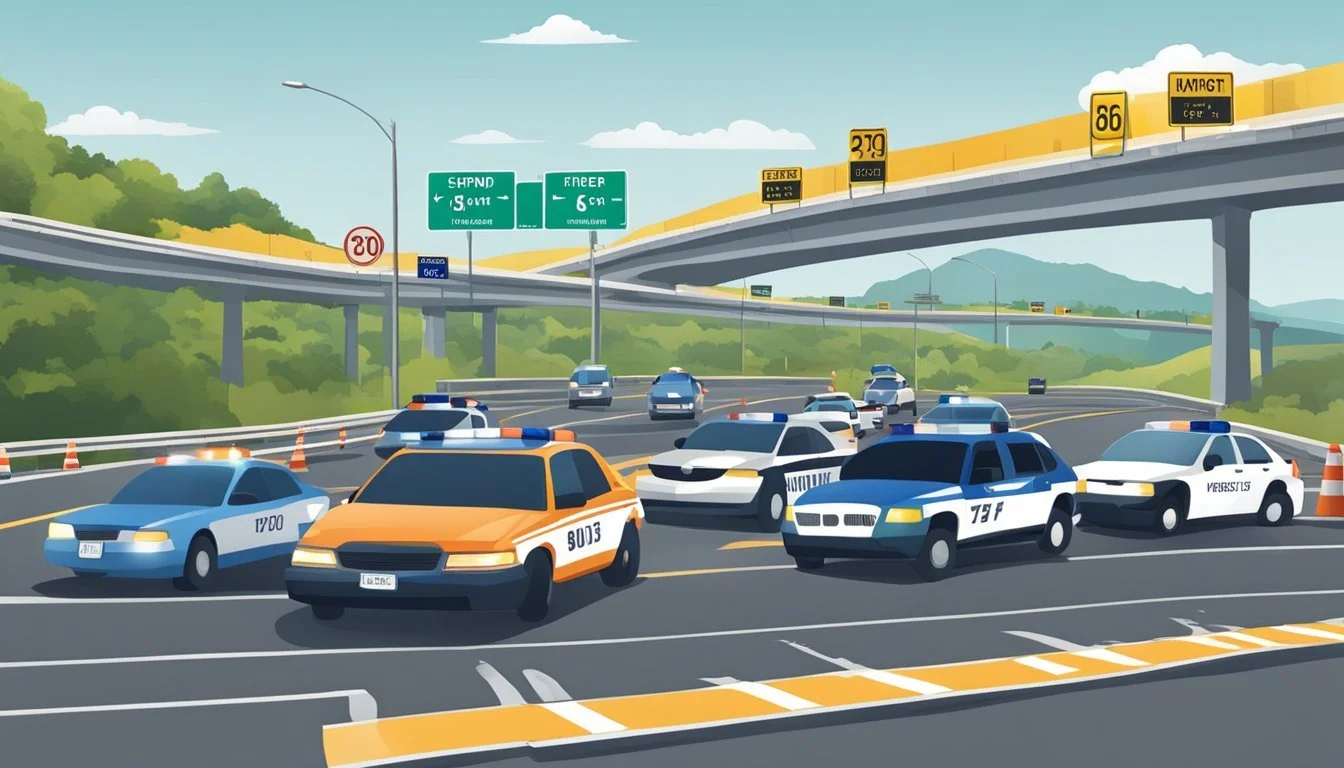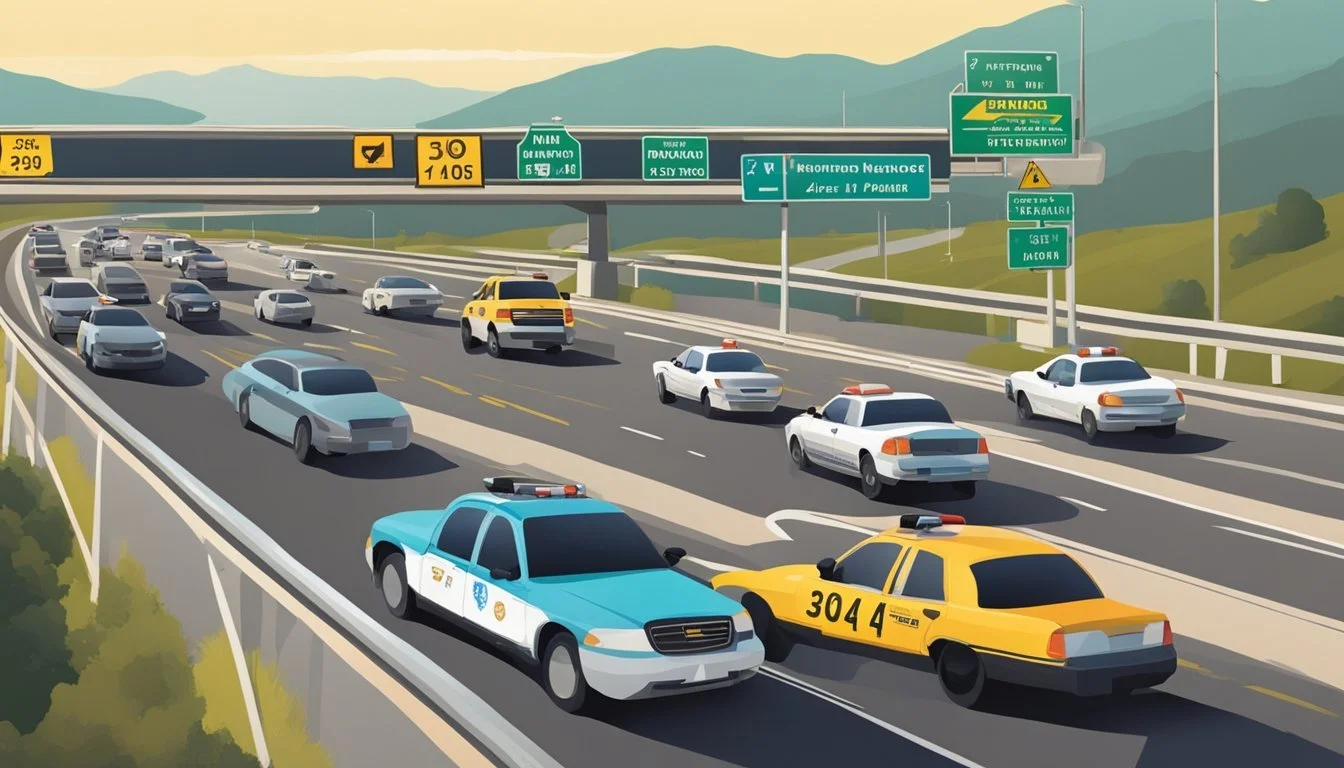Larry Eyler: 7 Highway Safety Measures Implemented After the Highway Killer's Spree
Roadway Protections Enhanced Following Serial Murders
Larry Eyler's reign of terror as the "Highway Killer" in the early 1980s left a lasting impact on the American Midwest. His horrific crimes, which claimed the lives of at least 21 young men, exposed vulnerabilities in highway safety and law enforcement practices of the time.
In response to Eyler's killing spree, authorities implemented several important safety measures to protect travelers and prevent similar crimes in the future. These changes aimed to enhance security along highways, improve communication between law enforcement agencies, and increase public awareness of potential dangers faced by motorists and hitchhikers.
1) Increased Police Patrolling
In the wake of Larry Eyler's killing spree, law enforcement agencies across the Midwest implemented heightened police patrols along highways and interstates. This measure aimed to deter potential criminal activity and increase the chances of apprehending suspects quickly.
State troopers and local police departments coordinated efforts to maintain a more visible presence on major roadways. They increased the frequency and duration of patrols, especially during nighttime hours when many of Eyler's crimes had occurred.
Officers received specialized training to identify suspicious behavior and potential signs of criminal activity along highways. This included looking for vehicles repeatedly circling areas or individuals loitering near rest stops and truck stops.
The increased police presence served multiple purposes. It reassured the public that steps were being taken to enhance safety on the roads. Additionally, it created a deterrent effect for would-be criminals who might think twice before attempting illegal activities.
Law enforcement agencies also established improved communication channels to share information about suspicious incidents across jurisdictions. This allowed for faster response times and better coordination in tracking potential suspects across state lines.
2) Installation of Surveillance Cameras
In response to Larry Eyler's crimes, authorities implemented enhanced surveillance measures along highways. Cameras were strategically placed at rest stops, truck stops, and other high-risk areas frequented by potential victims.
These surveillance systems provided law enforcement with valuable tools to monitor suspicious activities. The cameras acted as both a deterrent and an investigative aid, helping to identify vehicles and individuals of interest.
High-definition cameras with night vision capabilities were installed to ensure 24/7 coverage. Many systems included license plate recognition technology, enabling quick identification of suspect vehicles.
Real-time monitoring stations were established, allowing law enforcement to respond rapidly to emerging threats. The footage could also be reviewed later to assist in investigations and prosecutions.
While privacy concerns were raised, the general public largely supported these measures as a necessary step to enhance highway safety. The presence of visible cameras also helped reassure travelers and potentially deter criminal activity.
3) Enhanced Lighting on Highways
After Larry Eyler's crimes, many states prioritized improving highway lighting to enhance safety. Better illumination was seen as a deterrent to criminal activity and a way to increase visibility for drivers.
Highway departments installed more powerful and efficient lighting systems along stretches of road previously shrouded in darkness. LED technology allowed for brighter, longer-lasting lights that consumed less energy.
Strategic placement of lights focused on areas like entrance and exit ramps, rest stops, and emergency pull-offs. These spots were identified as potentially vulnerable locations for motorists.
Motion-activated lighting was implemented in some areas to conserve energy while still providing illumination when needed. This technology helped alert drivers to movement near the roadway.
Improved lighting not only deterred criminal activity but also reduced accidents caused by poor visibility. It allowed drivers to better see obstacles, wildlife, and other potential hazards on the road.
Some states also implemented blue light emergency phones along highways. These highly visible call boxes provided a lifeline for stranded motorists and a way to quickly report suspicious activity.
4) Community Safety Awareness Programs
In response to the Larry Eyler case, communities across the Midwest implemented safety awareness programs. These initiatives aimed to educate the public about potential dangers and promote vigilance.
Local law enforcement agencies organized town hall meetings to discuss personal safety strategies. They provided information on recognizing suspicious behavior and reporting concerns to authorities.
Schools incorporated safety lessons into their curricula. Students learned about situational awareness and the importance of traveling in groups when possible.
Community centers hosted self-defense workshops for residents. These classes taught basic techniques for protection and escape in dangerous situations.
Neighborhood watch programs expanded, with more residents participating in organized efforts to monitor their areas. This increased community engagement helped deter criminal activity and fostered a sense of collective responsibility.
Public service announcements aired on local television and radio stations. These messages reminded people to stay alert and take precautions when traveling or interacting with strangers.
Flyers and pamphlets with safety tips were distributed in high-traffic areas. These materials provided quick reference guides for personal security and emergency contacts.
5) Speed Limit Reductions
Following Larry Eyler's crimes, authorities recognized the need for enhanced safety measures on highways. One key initiative implemented was the reduction of speed limits in certain areas.
Transportation officials reassessed speed limits on stretches of road where Eyler had operated. They identified high-risk zones and lowered posted speeds to improve driver reaction times and reduce accident severity.
This measure aimed to give law enforcement more opportunities to spot suspicious vehicles and activities. Slower speeds allowed for increased vigilance by both police and motorists.
Some areas saw limits reduced from 65 mph to 55 mph, particularly near entry and exit ramps where Eyler often found victims. These changes were based on traffic safety studies and collision data.
Officials also installed more speed limit signs and increased enforcement efforts. The goal was to create a safer environment for all road users, especially vulnerable individuals like hitchhikers.
While not a direct response to Eyler's crimes, these speed reductions aligned with broader highway safety initiatives of the time. They formed part of a comprehensive approach to prevent future tragedies and protect travelers.
6) Emergency Call Boxes
Emergency call boxes were installed along highways in response to the Larry Eyler case. These devices provide a direct line of communication to emergency services for stranded motorists or those in danger.
The bright blue boxes are typically placed at regular intervals along roadsides. They allow drivers to quickly request help without relying on cell phones, which may have limited reception in remote areas.
When activated, call boxes connect users to dispatchers who can send police, ambulance, or roadside assistance. The boxes also pinpoint the caller's exact location, enabling faster response times.
This safety measure aims to prevent crimes like those committed by Eyler by giving potential victims a lifeline. It also assists in general roadside emergencies such as accidents or breakdowns.
Many states implemented call box systems in the years following Eyler's crimes. While less common today due to widespread cell phone use, they remain an important backup safety feature on some highways.
7) Improved Highway Signage
In response to the Larry Eyler case, highway authorities implemented enhanced signage systems across interstate routes. These new signs aimed to increase safety and provide clearer information to drivers.
Larger, more reflective signs were installed to improve visibility, especially at night. This helped drivers better navigate unfamiliar areas and reduced the chances of becoming lost or disoriented.
Emergency contact information was prominently displayed at regular intervals along highways. This allowed travelers to quickly report suspicious activity or seek help if needed.
Rest area locations were more clearly marked, encouraging drivers to take breaks and remain alert. Signs also included information about security measures in place at these stops.
Digital message boards were introduced on major highways. These allowed for real-time updates on road conditions, safety alerts, and other important information for travelers.
Mile markers were made more prominent and frequent. This helped drivers more accurately report their location in case of emergencies or when providing information to law enforcement.
Background on Larry Eyler
Larry William Eyler was an American serial killer active in the Midwest during the early 1980s. He targeted young men and teenage boys, leaving a trail of violence across multiple states.
Early Life and Criminal Activities
Born on December 21, 1952, Eyler grew up in Indiana. His troubled childhood included an absent father and allegations of sexual abuse. As a young adult, Eyler struggled with his sexuality and developed violent tendencies.
In 1978, he stabbed a male hitchhiker after a sexual encounter. The case was dropped when the victim refused to testify. This incident marked the beginning of Eyler's escalating criminal behavior.
Between 1982 and 1984, Eyler embarked on a killing spree. He abducted, tortured, and murdered at least 21 young men. His victims were often found along highways, earning him the moniker "Highway Killer."
Capture and Conviction
Eyler's crimes drew intense police attention. A breakthrough came when a tipster mentioned his name in connection with the murders. Investigators began building a case against him.
In 1984, Eyler was arrested for the murder of 16-year-old Daniel Bridges in Chicago. He was convicted and sentenced to death. While on death row, Eyler confessed to 21 additional murders.
Eyler died of AIDS-related complications on March 6, 1994, before his execution could be carried out. His case highlighted vulnerabilities in highway safety and led to increased awareness of crimes targeting LGBTQ+ individuals.
Highway Safety Improvements Post-Eyler Spree
In the wake of Larry Eyler's crimes, authorities implemented significant safety measures along highways. These initiatives focused on increasing police presence and enhancing support services for travelers.
Increased Patrols and Surveillance
State police departments bolstered their highway patrol units following the Eyler case. They deployed more officers to monitor high-risk areas and rest stops. Unmarked vehicles became more common, allowing for covert surveillance of suspicious activities.
Advanced technologies like automated license plate readers were installed at strategic points. These systems helped track vehicle movements and alert authorities to potential threats.
Many states also implemented helicopter patrols for aerial monitoring of remote highway sections. This provided a broader view of traffic patterns and isolated areas where crimes could occur.
Enhanced Roadside Assistance Services
Highway departments expanded their roadside assistance programs to reduce traveler vulnerability. Emergency call boxes were installed at regular intervals along highways, offering direct communication with authorities.
24/7 mobile repair services were introduced, providing quick help for stranded motorists. These services included fuel delivery, tire changes, and minor repairs.
States also launched public awareness campaigns about highway safety. They distributed informational materials at rest stops and gas stations, educating travelers on precautionary measures and emergency procedures.
Partnerships with local businesses near highways were formed to create safe zones for travelers needing assistance.
Impact on Public Awareness
Larry Eyler's killing spree sparked intense media attention and led to widespread public safety campaigns. The case highlighted vulnerabilities in highway safety and prompted a reevaluation of hitchhiking practices.
Media Coverage
News outlets extensively covered the Highway Killer case, bringing it to national attention. Major newspapers and television networks reported on the murders, manhunt, and subsequent trial. This coverage raised awareness about the dangers lurking on America's highways.
The media focus on Eyler's victims humanized them, moving beyond mere statistics. Personal stories and photographs of the young men resonated with the public, fostering empathy and concern.
Journalists also scrutinized law enforcement's handling of the case, exposing gaps in inter-state cooperation and evidence tracking. This critical coverage spurred improvements in police procedures and cross-jurisdictional communication.
Public Safety Campaigns
In response to the Highway Killer case, state and local governments launched safety initiatives. These campaigns aimed to educate the public about potential risks and promote preventive measures.
Key messages included:
Avoiding hitchhiking
Traveling in groups when possible
Staying alert at rest stops and truck stops
Reporting suspicious activity to authorities
Law enforcement agencies distributed informational pamphlets and erected warning signs along highways. Some states implemented emergency call box systems on remote stretches of road.
Universities and community organizations held safety workshops, teaching self-defense techniques and situational awareness. These efforts empowered individuals to take an active role in their personal safety while traveling.











